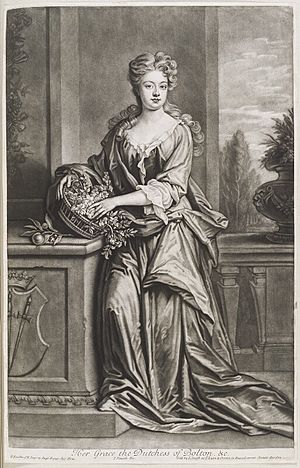Henrietta Paulet, Duchess of Bolton facts for kids
Quick facts for kids
The Duchess of Bolton
|
|
|---|---|

Henrietta Paulet (née Crofts), Duchess of Bolton, by and published by John Smith, after Sir Godfrey Kneller, Bt. Mezzotint, 1703 (c. 1700) NPG D11555.
|
|
| Born |
Henrietta Crofts
c. 1682 |
| Died | 27 February 1730 |
| Resting place | Basing House |
| Spouse(s) | |
| Children | Lord Nassau Powlett |
| Parent(s) |
|
| Relatives | Charles II of England (paternal grandfather) Jane Myddelton (maternal aunt) |
Henrietta Paulet, Duchess of Bolton (born Henrietta Crofts; around 1682 – 27 February 1730), was an important English noblewoman. She became the third wife of Charles Paulet, 2nd Duke of Bolton.
Henrietta was the elder daughter of James Scott, 1st Duke of Monmouth. Her mother was Eleanor Needham. Henrietta used the surname "Crofts" because her father had used it when he was a child. Her mother's sister, Jane Myddelton, was one of the famous Windsor Beauties, a group of beautiful women painted by Sir Peter Lely.
Contents
Henrietta's Marriage and Family
Henrietta married the Duke of Bolton in Dublin around 1697. This was several years after his second wife, Frances, had passed away. Henrietta was about twenty years younger than the Duke.
They had one son together:
- Lord Nassau Powlett (1698-1741). He married Isabella Tufton, who was the daughter of Thomas Tufton, 6th Earl of Thanet. They had one daughter.
Role in the Royal Court
From 1714 to 1717, Henrietta served as a Lady of the Bedchamber to the Princess of Wales, Caroline of Ansbach. A Lady of the Bedchamber was a high-ranking female attendant who helped the Princess with her daily life and duties.
Helping Others
Henrietta was known for trying to help her friends. After the Jacobite Rebellion of 1715, a time when some people tried to put a different king on the throne, Henrietta spoke to King George I. She tried to help her friend Anna Radclyffe, Countess of Derwentwater. Anna's husband, James, was sentenced to death for his part in the rebellion. Sadly, Henrietta's efforts were not successful.
She was also one of the important women who signed a petition to start the Foundling Hospital. This hospital was a special place for children who had no parents or who were in need of care. Thomas Coram presented this petition to King George II in 1735. Henrietta signed the petition on April 25, 1729. Historians believe that her family's own experiences might have encouraged her to sign. It is also thought that her step-daughter-in-law, Anne, who signed the petition a few days earlier, may have encouraged her.
Later Life and Legacy
A portrait of Henrietta, painted by Sir Godfrey Kneller, is kept at the Art Gallery of South Australia. The Royal Collection also has copies of this portrait.
Henrietta passed away in 1730 and was buried on March 10 of that year at Basing House. She did not leave a will.
Henrietta Street in Dublin might have been named after her. This street crosses Bolton Street, which was named after her husband. However, some people think it was named after Henrietta FitzRoy, Duchess of Grafton.
Images for kids


